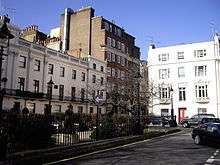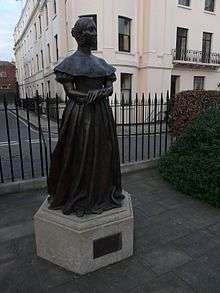Victoria Square, London


Victoria Square is a small residential square, located just to the south-west of Buckingham Palace, between Lower Grosvenor Place, Beeston Place, Grosvenor Gardens, and Buckingham Palace Road. It is on land forming part of the Grosvenor Estate to the south of the Royal Mews and to the north of the gardens of the Goring Hotel.
Architecture and history
The square comprises about 25 residential houses, which are all Grade II* listed as particularly important buildings of more than special interest. These are five-storey stucco-fronted properties designed by the architect Sir Matthew Wyatt (1805–1886), a member of the Wyatt family who was the son of sculptor Matthew Cotes Wyatt and the grandson of James Wyatt.[1] The houses were constructed in 1838–40[2] to celebrate the beginning of Queen Victoria's reign.
Most of the houses comprising Victoria Square are now held as freeholds, having been purchased from the Grosvenor Estate. The square lies within the Grosvenor Belgravia Estate Management Scheme, approved by the High Court in 1973 under section 19 of the Leasehold Reform Act 1967, the purpose of which is to preserve the appearance of the Belgravia area.
Renovation
The central square was recently renovated after residents contributed to a six figure sum towards the project. A statue of the young Queen Victoria by the artist Catherine Anne Laugel was specially commissioned and was installed in the square in 2007.
Former residents
Former residents include:
- Author Ian Fleming (1908–1964), who lived at number 16 Victoria Square from 1953 until his death in 1964.[3] The first of Fleming's James Bond novels, Casino Royale, was published shortly after he took his house on the square. Fleming threw a post-premiere party at 16 Victoria Square following the first showing of From Russia with Love on 10 October 1963.
- Former Conservative MP Michael Portillo (born 1953).[4]
- Poet Thomas Campbell (1777–1844), who lived at number 8 Victoria Square from 1840 to 1844.
- Musician John Ella (1802–1888), who lived at number 9 Victoria Square from 1868 to 1888.[5]
- Army officer, artist and author Henry Hope Crealock (1831–1891), who lived at number 20 Victoria Square from the 1860s until 1891.
- Musician and composer Mike Oldfield, lived for a period at 1 Victoria Square.
Appearance in film
In 1991, the square was used for the filming of the Merchant Ivory Productions adaptation Howards End.[6]
References
| Wikimedia Commons has media related to Victoria Square, London. |
- ↑ Curl, James Stevens (2006). A Dictionary of Architecture and Landscape Architecture. Oxford University Press.
- ↑ Hibbert, Christopher (2011). The London Encyclopaedia. Pan MacMillan.
p975
- ↑ Pearson, John (2011). The Life of Ian Fleming. Bloomsbury.
- ↑ Town, London. "Victoria Square, Pimlico, London SW1W | Nearby hotels, shops and restaurants | LondonTown.com". Victoria Square Guide. Retrieved 4 January 2015.
- ↑ Bashford, Christina (2007). The Pursuit of High Culture: John Ella and Chamber Music in Victorian London. Boydell Press. pp. 280–281.
- ↑ https://www.imdb.com/title/tt0104454/?ref_=adv_li_tt. Retrieved 24 January 2017. Missing or empty
|title=(help)